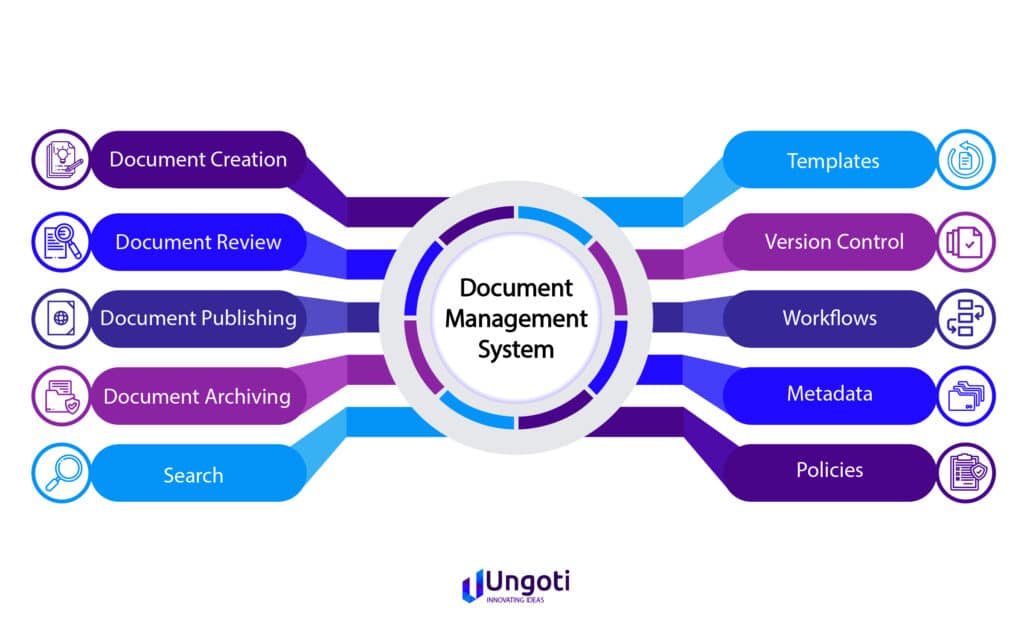In today’s fast-paced world, managing documents efficiently is crucial for businesses and individuals alike. The sheer volume of digital and physical documents can quickly become overwhelming without a proper system in place. That’s where Document Management Systems (DMS) come to the rescue. In this article, we will explore what a DMS is, how it works, its benefits, and why it is essential for modern-day organizations.
What Is A Document Management System (DMS)?
A Document Management System (DMS) is a software-based solution designed to capture, store, manage, and track documents, thereby streamlining the entire document lifecycle. It replaces the traditional paper-based filing systems with digital archives, making it easier to organize, search, and access files securely and efficiently.
Understanding The Components Of A DMS
- Document Capture
The document capture process involves digitizing physical documents and converting them into electronic format. This can be achieved through scanning, optical character recognition (OCR), and data extraction technologies. Capturing documents in a DMS ensures that information is easily retrievable and reduces the risk of document loss.
- Document Storage
A DMS offers a centralized repository for storing documents, allowing authorized users to access files from anywhere at any time. The storage can be on-premises or cloud-based, with the latter gaining popularity due to its flexibility and scalability.
Quick and accurate document retrieval is a key feature of a DMS. Users can search for documents using keywords, metadata, or full-text searches, making it effortless to find specific information within a vast collection of files.
- Document Security
Maintaining the security and privacy of sensitive documents is paramount. A DMS offers access controls, encryption, and audit trails to ensure that only authorized personnel can view, edit, or share certain documents, thus minimizing the risk of data breaches.
The Advantages Of Implementing A DMS
- Enhanced Organization and Accessibility
One of the primary benefits of using a DMS is the enhanced organization it brings to document management. With files stored in a structured and searchable manner, employees can quickly locate the information they need, leading to improved productivity and reduced time wasted searching for documents. Moreover, version control features ensure that everyone is working on the latest document iteration, avoiding confusion and errors caused by outdated files.
- Increased Collaboration and Workflow Efficiency
A well-implemented DMS fosters collaboration among team members, regardless of their physical location. Multiple users can simultaneously access and work on the same document, facilitating real-time editing and feedback. This collaborative approach streamlines workflows, expedites decision-making processes, and encourages seamless communication, ultimately boosting overall productivity.
- Improved Data Security and Compliance
Data security is a top priority for businesses, particularly those handling sensitive information. A DMS provides robust security features, such as encryption and access controls, safeguarding confidential data from unauthorized access. Additionally, it aids organizations in adhering to various compliance regulations, such as GDPR and HIPAA, by ensuring data retention policies are enforced and audit trails are maintained.
- Cost Savings and Environmental Benefits
Implementing a DMS can lead to significant cost savings over time. The reduction in paper usage and physical storage needs not only cuts down operational costs but also contributes to a greener environment. Embracing digital document management aligns with sustainable practices, minimizing a company’s ecological footprint while optimizing resource allocation.
Disadvantages Of Document Management Systems (DMS)
While Document Management Systems (DMS) offer numerous advantages, they are not without their drawbacks. It’s essential to be aware of these potential disadvantages before implementing a DMS within your organization:
- Initial Cost and Setup
The initial investment in a DMS can be significant. Costs may include software licenses, hardware infrastructure, employee training, and data migration. Small businesses or organizations with limited budgets might find it challenging to afford the upfront expenses.
- Time-Consuming Implementation
Implementing a DMS requires careful planning and execution, which can be time-consuming. The process of data migration, system customization, and training employees on the new system may cause temporary disruptions to regular operations.
- User Resistance and Training Needs
Introducing a new system often meets resistance from employees who are accustomed to familiar processes. Convincing them of the benefits and providing comprehensive training to ensure a smooth transition may pose challenges.
- Dependency on Technology
A DMS relies heavily on technology, which means any technical issues or system downtime could disrupt document access and workflow. Organizations need to have contingency plans in place to handle such situations promptly.
- Security Concerns
While DMS systems come with robust security features, they are not immune to cyber threats. Data breaches or unauthorized access could compromise sensitive information. Organizations must continuously update security measures to stay ahead of potential risks.
- Potential for Data Loss
If not backed up properly, there is a risk of data loss in case of hardware failure or other unforeseen incidents. Regular backups and disaster recovery plans are essential to mitigate this risk.
- Learning Curve
Despite user-friendly interfaces, employees might take some time to adapt to the new DMS. This learning curve can lead to temporary productivity dips during the early stages of implementation.
- Compatibility Issues
DMS systems must be compatible with existing software and tools used within the organization. Integration challenges could arise if the DMS does not seamlessly work with other critical applications.
- Overwhelming Amount of Data
While DMS aims to organize information, it can accumulate a vast amount of data over time. Without proper organization and data management practices, finding specific documents may become challenging.
- Lack of Personal Touch
Some employees may miss the personal touch associated with physical documents. Handwritten notes, signatures, and the tangible feel of paper can be lost in a purely digital environment.
How To Choose The Right DMS For Your Needs
Selecting the most suitable DMS for your organization requires careful consideration of specific requirements and objectives. Here are essential factors to keep in mind:
- Assessing Your Document Management Requirements
Before exploring various DMS options, it’s crucial to identify your organization’s specific needs. Consider factors like the volume of documents to be managed, the number of users who will access the system, and the desired level of integration with existing software solutions.
- Scalability and Integration
As your business grows, so will your document management needs. Opt for a DMS that is scalable and can accommodate future expansion without compromising performance. Additionally, compatibility with other tools and software in your tech stack will ensure seamless integration and a cohesive workflow.
- User-Friendly Interface and Training
A user-friendly interface is essential for the successful adoption of a DMS across your organization. The system should be intuitive, requiring minimal training for users to become proficient. Invest in comprehensive training programs to help employees leverage the full potential of the DMS effectively.
- Security Features and Compliance
Given the sensitivity of the documents managed by the system, robust security features are non-negotiable. Ensure the DMS complies with industry standards and regulations to maintain data privacy and protect against potential cyber threats.
Implementing A DMS: Best Practices For Success
Successfully implementing a Document Management System requires careful planning and execution. Here are some best practices to ensure a smooth transition and optimal utilization of the system:
- Planning and Goal Setting
Before rolling out a DMS, create a detailed plan outlining the objectives and goals of the implementation. Identify key stakeholders and involve them in the decision-making process. Set realistic timelines and allocate resources for training, data migration, and system testing.
- Phased Implementation Approach
Rather than attempting a full-scale rollout all at once, consider a phased implementation approach. Start with a pilot program involving a smaller group of users to test the system’s functionality and gather feedback. Based on the insights gained, make necessary adjustments before expanding the deployment.
- User Adoption and Training
A successful DMS implementation heavily relies on user adoption. Encourage employee buy-in by highlighting the benefits of the system and demonstrating how it streamlines their workflows. Provide comprehensive training sessions and ongoing support to ensure users are confident in navigating the DMS.
- Regular Evaluation and Updates
Document management needs evolve over time, so it’s essential to regularly evaluate the system’s performance and make updates as needed. Gather feedback from users and assess how well the DMS aligns with the organization’s changing requirements. This iterative process will ensure the DMS remains relevant and effective.
Common Challenges In Document Management And How To Overcome Them
- Resistance to Change
Introducing a DMS may face resistance from employees accustomed to traditional methods. To address this, communicate the advantages of the system transparently and involve employees in the decision-making process. Assure them that proper training and support will be provided to ease the transition.
- Data Migration and Integration Issues
Migrating existing documents to a new DMS can be complex. Ensure that the migration process is thoroughly planned and tested to avoid data loss or inconsistencies. Additionally, verify the DMS’s compatibility with other systems used in the organization to achieve seamless integration.
- Ensuring Document Privacy and Security
Data security is of utmost importance when managing sensitive documents. Implement access controls, encryption, and user authentication to safeguard information from unauthorized access. Regularly update security protocols to stay ahead of potential threats.
Document Management Trends To Watch
- Cloud-Based DMS Solutions
Cloud-based DMS solutions offer enhanced flexibility and accessibility. The ability to access documents from any location and device is particularly advantageous for remote and distributed teams.
- AI and Automation Integration
Integrating artificial intelligence and automation in DMS streamlines document processing, classification, and retrieval. AI-driven features like auto-tagging and smart search significantly improve efficiency.
- Mobile Document Management
Mobile-friendly DMS applications enable users to access and collaborate on documents from their smartphones and tablets, further enhancing productivity and responsiveness.
- Blockchain for Enhanced Security
Blockchain technology can be used to create an immutable and tamper-proof audit trail, ensuring the integrity and authenticity of critical documents.
The Future Of Document Management
- Evolving Technologies and Innovations
The field of document management is constantly evolving, with new technologies continually shaping its landscape. Keep an eye on emerging trends and innovative solutions to stay ahead in the digital age.
- Impact on Business Operations and Sustainability
A well-implemented DMS can have a profound impact on an organization’s efficiency, productivity, and sustainability efforts. By reducing paper usage and optimizing workflows, businesses can make significant strides towards becoming eco-friendly.
- The Role of AI and Machine Learning
AI and machine learning will play an increasingly significant role in document management. From intelligent document classification to predictive analytics, these technologies will revolutionize how organizations handle and leverage their information.
Conclusion
In conclusion, a Document Management System (DMS) is a transformative tool that can revolutionize how organizations handle their documents. By streamlining document capture, storage, retrieval, and security, DMS enhances productivity, collaboration, and data protection. When selecting a DMS, consider factors such as scalability, integration, user-friendliness, and security features.
Embrace the best practices for successful DMS implementation, including careful planning, phased deployment, user training, and regular evaluation. Overcoming challenges like resistance to change and data migration issues will pave the way for a seamless transition.
As technology continues to evolve, keep an eye on the latest trends in document management, such as cloud-based solutions, AI integration, and mobile accessibility. These advancements will shape the future of document management and redefine how businesses operate in the digital era.






